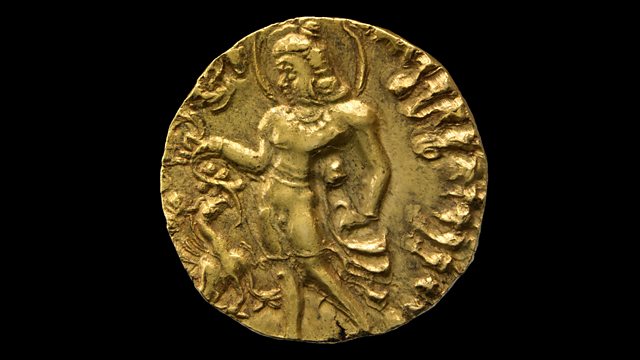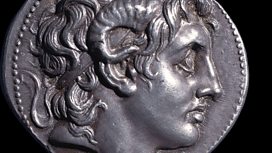Gold coin of Kumaragupta I
The history of the world as told through one hundred objects from the British Museum. Today Neil MacGregor is looking at the rise of religious imagery in India under the Guptas.
This week Neil MacGregor is exploring how several of the great religions around the world, less than 2000 years ago, began creating sophisticated new images to represent their beliefs and their deities. Many of the images created then are still with us today and remain essential forms of veneration. These include the images of the gods and goddesses of Hinduism, whose recognisable modern form can be seen on coins from the Gupta empire which flourished in India from around 320 to 550 AD. The Gupta period is regarded by many Indians as a golden age, a time when Indian cultural life and religion came together to create temples and texts that are central to Hinduism today. The growing sophistication of the time is explored with the help of the historian Romila Thapar and the Hindu cleric Shaunaka Rishi Das
Producer: Anthony Denselow
Last on
![]()
Discover more Leaders & Government programmes from A History of the World in 100 Objects
About this object
���dz����پ��Dz�:�� North India
Culture: Ancient South Asia
Period: AD 415-450
Material: Gold
��
This coin was created to commemorate the Gupta horse-sacrifice or asvamedha. During this ritual a stallion was released to roam for a year. The royal court followed the wandering stallion and prevented him from mating. At the end of the year the sexually-frustrated horse was looked after by the royal women, before being sacrificed by the king using a golden dagger. King Kumaragupta I is said to have completed this ritual twice in his lifetime.
When did Hinduism first develop in India?
The Gupta Empire dominated the Indian subcontinent from about AD 320 to 550. During this period the old Vedic rituals like the asvamedha began to die out. They were replaced by a templebased religion that we would recognise today as Hinduism. As well as a belief in reincarnation, karma and the caste system, Hinduism saw the old Vedic gods merge with an array of popular and native gods. The goddess Sri-Lakshmi on this coin became the consort of the supreme Hindu god Vishnu.
Did you know?
- For Indians today the Gupta period is a golden age, when the great epics the Mahabharata and Ramayana were written down.
Deciphering a golden age
By Joe Cribb, Research keeper, British Museum
��
The rule of the Gupta kings was probably the most important period in the history of Ancient India, but by the early nineteenth century knowledge of this 'Golden Age' had almost disappeared there. Europeans working with Indian scholars gradually reconstructed India's ancient history, by collecting and translating ancient Sanskrit and Pali literature, deciphering the scripts used in ancient India and recording the monuments, antiquities and coins of the period. For the Gupta period gold coins like this one were the most numerous surviving records.
In the 1830s James Prinsep, a British civil servant based in Calcutta deciphered the ancient scripts and read the inscriptions on these coins. He was able to link them with inscriptions on stone to suggest a chronological context for the Gupta kings in the middle of the first millennium AD. Our present knowledge of the history of the Gupta kingdom is based on these and more recently discovered inscriptions and coins.
The coins are only representations of the kings, showing their regalia, costumes and religious affiliation and practice. The dominant religious images on the coins are the bird-man god Garuda, the mount of Vishnu, and Sri Lakhshmi, Vishnu's spouse.
Kumaragupta's coins are an exception, as they represent his name-god Kumara, more commonly called Karttikeya today. Alongside the cult of the gods, the representation of Horse Sacrifice on the coins of Samudragupta and Kumaragupta show a different form of religious practice, based on the Vedic tradition, which predates the cult of Vishnu and Kumara, a more recent development in Hinduism. The coins continue to be a vital source for our study of ancient Indian history.
Creating a golden age
By Romila Thapar, Indian historian
��
When colonial history began to be written, and then there was nationalist historic writing, there was a search for golden ages. Because in those days every culture, every civilisation had to have a golden age. And so the Gupta period was latched on to as that golden age because, for a variety of reasons, there was a change in the Hindu religion.
There was the beginnings of very remarkable Sanskrit literature; literature in Sanskrit, and there was an absolute efflorescence of art - Buddhist art as well as the beginning of the representation of Hindu deities. So this became the golden age, and also added to this was the fact that some of the Gupta kings fought against the Sakas – the Scythian rulers of western India in the northwest who were regarded as foreigners - and against the Huns who came from central Asia – again foreigners – so that tied in with nationalism. The fight is “against the foreigner”, and the Guptas were the dynasty that stood up to the foreigners.
So all these factors came together in making the Guptas a kind of symbol of the golden age and of national revival. And then of course to crown it all it was said that the Guptas were the ones who patronised the new puranic Hinduism. And therefore gave strength to Hinduism because at this time it was a delicate balance between Hinduism and Buddhism and it wasn’t clear as to which of the two would become the dominant religion.
A focus of worship
By Shaunaka Rishi Das, Director of the Oxford Centre for Hindu Studies, University of Oxford
��
There are very clear instructions given to kings in India in many scriptures, and they are all told to be very tolerant of religious peoples and intellectuals and - interestingly enough - people of no particular faith. They should all be tolerated and in that mood of tolerance people started to work together – traditions that already existed began to work together and some took off in a completely different way.
The number of deities is very interesting, you can count up to millions of different deities, but not all of them are considered to be divine in the sense of being the Godhead, that’s very few.
There are traditions that worship particularly Vishnu, and the manifestations of Vishnu which famously would be Krishna and Ram – I think Krishna would be the most popular deity in India. And then Shiva would come not too far behind, and Shiva and Parvati go together, and then Parvati in the form of Durga or Kali is also worshipped separately. So it is God manifest in many different ways.
The idea of the deity is the same as in any tradition, that you have a focus of worship. But it is important to fix our minds and not be eclectic. So you practice the presence of God in your life - by going to the temple where you see the image that is the presence, you bow down in front of the image, you offer food or incense, you say your prayers or you just enjoy the presence of God – in meditation, in chanting, people do yoga.
Transcript
Broadcasts
- Tue 1 Jun 2010 09:45������̳ Radio 4 FM
- Tue 1 Jun 2010 19:45������̳ Radio 4
- Wed 2 Jun 2010 00:30������̳ Radio 4
- Tue 9 Mar 2021 13:45������̳ Radio 4
Featured in...
![]()
Leaders and Government—A History of the World in 100 Objects
More programmes from A History of the World in 100 Objects related to leaders & government
Podcast
-
![]()
A History of the World in 100 Objects
Director of the British Museum, Neil MacGregor, retells humanity's history through objects





